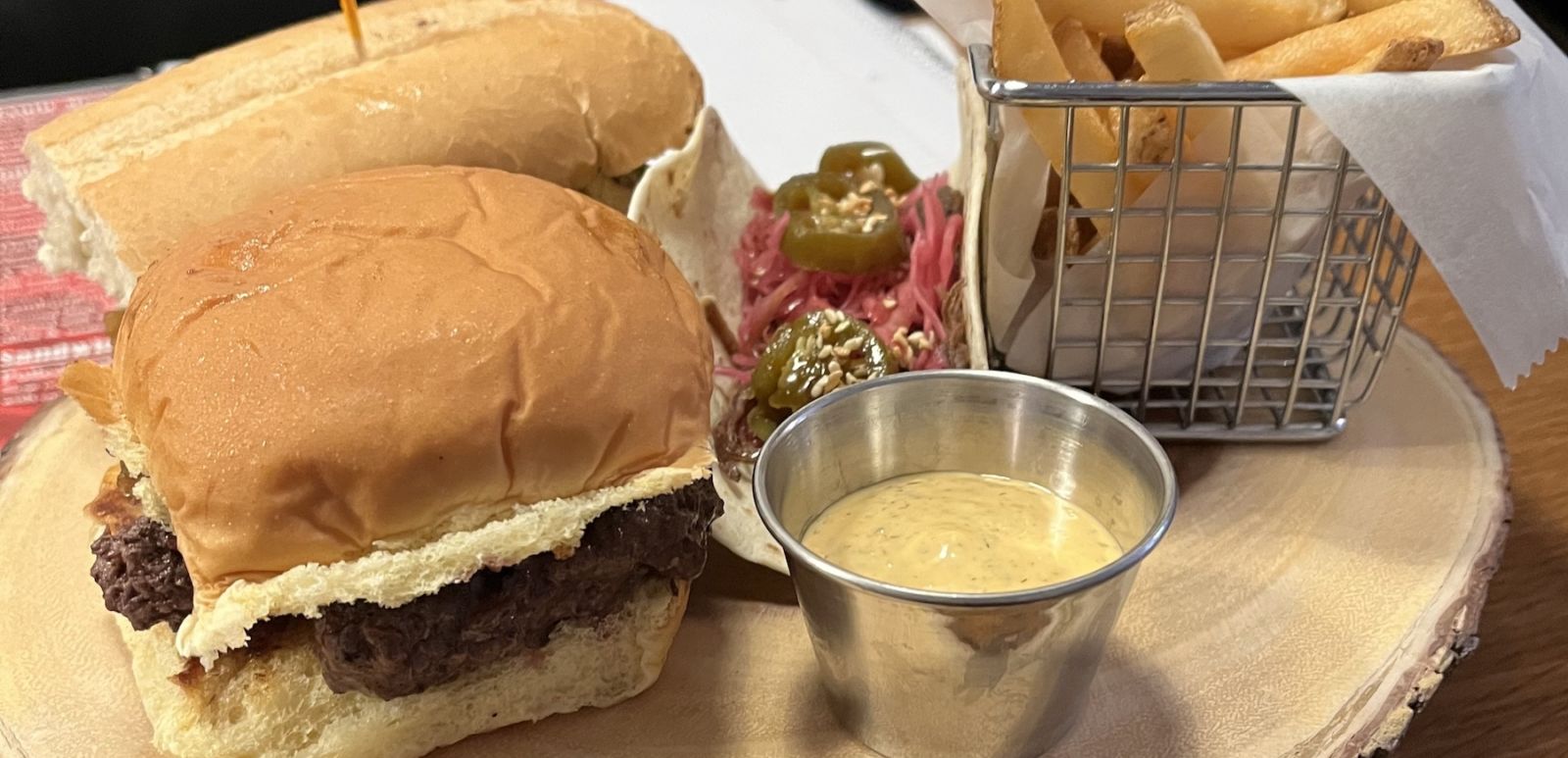“I don’t hunt” is one of the first things Tyrone Green says to me. We have just sat down at a booth made of a large slice of polished tree trunk, the bark still thick and gleaming on its edges. On the wall of the narrow New York City establishment are mounted animal heads — moose and the like — but they’re fake, made of cardboard or fabric and stuffed with what I can only assume is polyester. Green disagrees with hunting for sport and does not allow any real animal heads in his Hell’s Kitchen restaurant, Dark Side of the Moo. “I love animals,” he says.
Soon, however, there is a lot of animal between us. On a tray made of yet another, smaller piece of tree trunk is a Kalua pua’a pulled wild boar taco, the light brown meat hidden beneath pink pickled onions and jalapeños, a Cajun-style smoked alligator sausage inside a dry baguette and a yak slider, dressed and lean on its bun. These aren’t beasts commonly found on a New York menu, and that’s the point. Dark Side of the Moo is a proud purveyor of exotic meat.
Avowed exotic-meat enthusiasts compose a loose community ostensibly of Westerners who want to eat animals they don’t see grazing alongside country roads. Each exotic-meat eater has their own motivations. Many who sell it do so for attention, a bid to attract media and tourists like those who flood Times Square, which sits a few blocks away from Dark Side of the Moo, to what would otherwise be just another restaurant. Some come for the adventure, and a few of these adventurous types have gotten flack for seeking out endangered species like lions. Green thinks those guys can “fuck off.”
Yet, inchoate as it is, exotic meat represents a slowly growing movement. W Ottomanelli Bros., a New York City butcher that opened in 1900, sells an array of exotic meat. Last year, YouTuber Jeffree Star sold his $15 million Los Angeles mansion to raise yak meat in Wyoming. Cipriani, one of New York’s most fashionable Italian restaurants, announced that Fossil Farms, an exotic-meat ranch that prides itself on sustainably raising its animals, would open a counter at one of its locations. That word, sustainability, has perked the attention of both Green and his patrons. Green believes his restaurant represents a healthier, more sustainable, more ethical alternative to the Bermuda Triangle of factory-farmed animals — cow, chicken and pig — one that can alleviate pressure on the behemoth animal agriculture industry. The question remains, is he correct? Or is exotic meat just another tourist trap?
Is it Really Exotic?
Many who sell “exotic meat” don’t label it as exotic. It is simply what the sellers like to eat. Just in New York City, there’s an Australian restaurant in Queens that sells a kangaroo burger, an African cafe in the West Village that sells camel kofta, an Ecuadorian coffee shop, also in Queens, that sells guinea pig and a Cajun restaurant that sells alligator. According to Green, high-end restaurants also like to dabble in racks of elk.
“Exotic” is an exceedingly relevant, often political term, one that has been used to exclude or demean minority communities in the United States. In the case of exotic meat, the term is classist and Eurocentric. Obviously, yak is not exotic in Nepal, nor is alligator exotic in Louisiana. Green, who is originally from the United Kingdom, defines exotic as anything that is not local to a region. In New York, he considers himself exotic.
As far as meat goes, Green thinks of exoticness on a spectrum. On the tame end, there’s the meat you can commonly find in fast-food drive-throughs. In the middle is the somewhat gray area of game meat like bison, lamb and maybe wild boar. On the far end is the truly exotic fare. Here, Green includes yak, camel and alligator.
Bison, lamb, yak, alligator, boar, kangaroo and elk all regularly appear on Dark Side of the Moo’s Hell’s Kitchen menu. At the Jersey City location, there’s a camel burger. If he can get his hands on it, Green will make specials like guinea pig empanadas, ostrich bulgogi, quail lollipops and snake Thai spring rolls. “Snake is boring. It tastes like chicken,” Green says.
Green receives strange meat requests. One guy from Virgina tried to unload three camel carcasses onto him, which Green could not accept because he had no way to safely process the meat. Another requested squirrel, which, because there are so few facilities to process it, costs $40 a pound, $5 more than snake. “To me it’s like buying rat for $40 a pound. Why would I buy rat?”
Green was initially drawn to exotic meat as a way to stand out among other burger and sandwich joints. In fact, his favorite reaction to his menu is “horror, because I know they’re going to tell someone. It’s publicity by notoriety.” Now, he embraces exotic meat as means of healthier, more sustainable meat consumption. Green is specific about his sourcing. He does his best to ensure his exotic meat is pasture-raised and fed a natural diet. A significant portion of it he gets from Fossil Farms.
The Case of the Boar
Dark Side of the Moo’s customers seem to see the ethics of exotic meat, too. According to Green, many patrons are ethically conscious millennials looking for sustainably raised meat and gym buffs looking for a high-protein meal that is lower in fat, which Green claims much of his exotic meat is. Other people, like Christopher Schlottman, a clinical professor of environmental studies at New York University, are unconvinced.
Schlottman is an ethicist who spends his days thinking about animals, the environment and food. His research has led him to advocate for the idea of maximizing flourishing, what allows for a good life for all beings. In terms of animal welfare, he agrees that a pasture-raised animal is probably happier than a factory-farmed one. If the exotic animal spends its days clomping over expansive open spaces and munching on grass before becoming packaged meat, then it probably lived a fuller life than an animal who spends even a few of its days on a crowded feedlot sloshing about in manure.
He also points out that there is a sound biological argument for genetic diversity, that to have a greater number of animals in our ecosystem makes the ecosystem more resilient, especially to agents like zoonotic disease. Though, in the case of exotic meat, Schlottman says there are two significant caveats. First, there is little research on retail exotic meat’s relationship with zoonotic diseases; and, second, the consumption of animals that are quite literally off the beaten path has been linked to an increased risk for the spread of zoonotic diseases.
On the charge of exotic meat’s sustainability, Schlottman is incredulous. “It’s boutique on boutique,” Schlottman says, and thus far too small to divert any kind of meaningful consumer base from factory-farmed meat. Even if it did become popular enough to have an industry-level impact, scaling up the production of exotic meat becomes a problem in the same way it is for chicken, pork and beef, who have resolved the issue of high demand with factory farms.
Then, there’s the issue of factory farms. The science is still out on whether grass-fed beef is more eco-friendly than factory-farmed, and there exists quality studies and fierce advocates on either side of the debate. At the end of the day, the only way to reliably reduce the carbon footprint of your meat is to not eat it. Schlottman says those who do choose to eat pasture-raised meat, like Green’s exotic meat, do more to help themselves feel better than they do to help the planet.
“We should see our individual behavior in that light, right? This is virtuous, but not necessarily hugely consequential,” Schlottman says.
The case of the wild boar lingers. Wild boar — and their kin, feral pigs, with whom they often coexist and interbreed, creating hybrid herds of super pigs — are human-like in the way they go forth and multiply, and in the way they will destroy an environment to support their multiplication. The animals are voracious, what scientists called “opportunistic omnivores,” eating anything with energy in it, be it a field of farmer’s corn, roots they’ve dug up from three feet underground or a lamb. Wild boars will turn an environment inside out to sustain themselves. In the now 39 states in which they roam, wild boars have destroyed agricultural fields, eaten up the diversity of native plant species and allowed invasive weeds to move in, munched on multiple endangered species, including sea turtle eggs, caused algal blooms in the waters they bathe in and promoted erosion — among many other things. All together, in the United States, these indomitable pests shoulder the blame for upwards of $2 billion in damage annually.
They are also pretty tasty. Wild boar sat at the center of Michael Pollan’s “perfect meal.” Pollan described the roasted leg of the boar he shot himself as “delicious, with a nutty sweetness that tasted nothing like store-bought pork.” The taco I ate, too, tasted good, not nutty sweet, but surprisingly mild and satisfying. The boar Green sells comes from Texas, the state with one of the largest and most intractable wild boar infestations, where ranchers round up the boars, kill them and sell them as a way to manage the animal’s population. Hunting can be risky — boars are intelligent and will seek new territory under the pressure of a hunt — and experts are still investigating the best way to cull populations. It seems some techniques, like trapping, work better than others, like hunting the boars from a helicopter.
After my meal at Dark Side of the Moo, I pose the question of the wild boar taco to Schlottman: Is it better to eat wild boar, an avowed pest that destroys the environment, than a factory-farmed burger? Schlottman, who is a vegan, appears mildly agitated. “If you had to choose, probably the invasive wild boar.”




